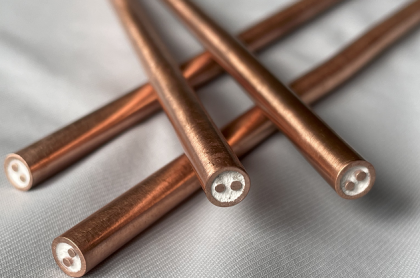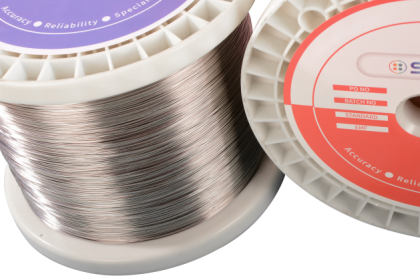The service life of thermocouple is related to its deterioration. The deterioration is the phenomenon of aging and metamorphism of the thermocouple . Thermocouple gradually grows in their internal grains at high temperatures. At the same time, the alloy contains a small amount of impurities, and its position or shape will also change. Moreover, it also reacts with the gas in the surrounding environment. Along with the above changes, the thermal electromotive force of the thermocouple also changes extremely sensitively. Deterioration is therefore inevitable and a quantitative change process.
1. Deterioration of Noble Thermocouple
1.1. Temperature
When t > 1400℃, platinum will recrystallize, not only to reduce the tensile strength of the coupling wire, but also to increase the possibility of gas contamination along the intergranular boundary. Therefore, the long-term use of S-type thermocouple temperature should not exceed 1400 ℃.
1.2. Use of Atmosphere
(1) Safe for use with clean air, N2 and CO2;
(2) Under high temperature and vacuum conditions, the platinum pole of S-type thermocouple is polluted by rhodium vapor, which causes the thermal electromotive force to decrease. Therefore, under high temperature and vacuum conditions, it cannot be used in the form of thermocouple bare wire for a long time. A protective tube must be added.
(3) Reducing Atmosphere
A. Due to the small atomic radius of hydrogen, the penetration is extremely strong. It can penetrate almost all protective tubes at high temperature, which can not only make platinum brittle, but also react with platinum to lower its melting point;
B. The presence of carbon or carbide can react with platinum to form carbides such as platinum carbide and become brittle;
C. If the refractory contains compounds of elements such as Se, P, S, As, Pb, Al, Zn, Cd, Sn, etc., they will be reduced by reducing gases and form compounds or low melting point alloys with Pt which causes the Pt to become brittle quickly or break.
2. Deterioration of Base Metal Thermocouple
The deterioration of the K-type thermocouple is greatly related to the surface state of the Ni-Cr pole. Therefore, it can be divided into two types: normal deterioration and abnormal deterioration according to the surface state. Different causes of deterioration have different effects on thermal electromotive force, and the direction is just opposite. The direction of normal deterioration is positive, and the direction of abnormal deterioration is negative.
2.1. Normal Deterioration
The Ni-Cr hot electrode wire forms a dense protective film of Cr2O3 on its surface, which provides excellent protection to its internal alloy. The deterioration process is slow, and its thermoelectric potential changes in the positive direction. The temperature indication develops towards the higher direction.
2.2. Abnormal Deterioration
Deterioration caused by improper thermocouple production process, which fails to completely form a Cr2O3 protective film on the surface, but forms a part of the composite oxide NiCr2O4 with a spinel structure. Compared with Cr2O3, NiCr2O4 has a looser structure and the combination of the thermal electrode wire isn’t solid either. Therefore, when used at high temperature, the oxidation rate is very fast. Moreover, during the heating and cooling process, the oxide film will also crack or peel off, thereby further promoting oxidation. The result passes the highest point in a very short time and changes in the negative direction.
2.3. Deterioration Caused by Unsuitable Use Conditions
(1) Selective Oxidation of Chromium
At low oxygen partial pressure, selective oxidation of chromium in nickel-chromium poles occurs. This causes a green oxide layer to appear on the surface, often referred to as "green corrosion". This excess thermal potential due to reduced chromium content has become a limiting factor in the long-term use of K-type thermocouple.
If the gas used is pure, the life of the thermocouple can be extended due to the absence of oxygen in the system. However, if there is already an oxide layer on the surface of the thermocouple wire, it will still provide enough oxygen for the selective oxidation of chromium. Therefore, when applying in a non-oxidizing atmosphere, use clean, polished coupling wire. In the meanwhile, use in an inert gas with traces of oxygen or in an atmosphere with very low oxygen partial pressure should be avoided as much as possible. When the ratio of the length of the protection tube to the diameter of the tube is large (the protection tube is thin), due to poor air circulation caused by the lack of oxygen, the residual oxygen can still provide conditions for the selective oxidation of chromium. This can be used to increase the diameter of the protective tube or the use of absorbent to prevent oxidation.
(2) Phenomenon
A. Normal thermal electrode wire surface has a silvery gray metallic luster (not oxidized). After oxidation, there are green scales on the surface or under the surface layer;
B. If the bending hot electrode wire becomes brittle due to selective oxidation, its surface will be cracked;
C. The positive electrode is non-magnetic and will become magnetic after oxidation;
D. The thermoelectric potential will produce 10°C to 100°C in a very short time of negative deviation.
(3) The Effect of Reductive Atmosphere
Decrease in chromium concentration due to carburization and selective oxidation of chromium at high temperature was the main reason for the deterioration of K-type thermocouple. In this reducing atmosphere, nickel-chromium pole surface cracking and surface layer peeling due to free carbon precipitation. Internal oxidation also proceeds rapidly, and the concentration of chromium decreases significantly.
3. Deterioration of Tungsten Rhenium Thermocouple
3.1. The Effect of Various Atmospheres
(1) Tungsten rhenium thermocouple is stable in an inert atmosphere and in dry hydrogen with a high thermoelectric potential;
(2) Tungsten rhenium thermocouple is suitable for high temperature vacuum conditions. Under the same conditions, tungsten rhenium thermocouple (5/26) is more stable and have a longer life than platinum rhodium thermocouple;
(3) Under high temperature carbon atmosphere, tungsten rhenium thermocouple and insulating material will interact with carbon, generating complex compounds and eutectic, making the coupling wire brittle, lower melting point and deposited carbon will cause a short circuit thermocouple, causing thermodynamic drift;
(4) In air, the intense volatilization of oxidation products leads to the rapid rupture of the protective oxide layer formed at the beginning of oxidation, so that the controlling step of the oxidation process changes from the diffusion of oxygen through the oxide film to the chemical reaction at the metal or oxide interface, thus exhibiting a catastrophic oxidation law. At high temperature and low oxygen partial pressure, the oxide film of tungsten rhenium hot electrode wire undergoes a sintering reaction, forming a more dense double-layer structure of the oxide film and thus its corrosion rate is reduced.
3.2. High Temperature Stability of Thermoelectric Potential
The thermoelectric potential of tungsten-rhenium thermocouple may change abruptly at high temperature. The reason is not due to the selective oxidation of alloying elements, but due to the complete oxidation of a certain electrode in the thermocouple, which leads to a qualitative change in the properties of the material, which leads to a fundamental change in the corresponding thermoelectric properties; due to the oxidation of the tungsten-rhenium alloy, the generated ReO3 has a high electrical conductivity, so that the thermoelectric potential still appears in the thermocouple circuit after failure; secondly, the resistance and electromotive force of the tungsten-rhenium thermocouple have the characteristics of simultaneous mutation. Therefore, it is possible to predict its lifetime by measuring the change in resistance.
4. Deterioration of thermocouples for carburizing furnaces and countermeasures
4.1. Problems
(1) Short Thermocouple Life and Large Deviation
A. Service life is only 1 to 2 weeks
B. The drift direction of the thermocouple are negative deviation, a little carelessness is easy to occur in the workpiece over-burning quality accident
(2) Severe Corrosion of Thermocouple
After use, K-type thermocouple became white at the negative pole and green at the positive pole near the measurement end. Even with the use of American-made coupling wire, the life time in the carburizing furnace is very short.
4.2. Methods
(1) Replace stainless steel protection tube with heat resistant steel tube
(2) Prevention of reducing gas infiltration, using composite tube type solid thermocouple











 IPv6 network supported
IPv6 network supported